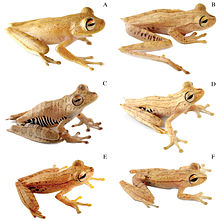The Papallacta tree frog is a species of frog in the family Hylidae found in Colombia and Ecuador. Its natural habitats are subtropical or tropical moist montane forests and rivers. Scientists have seen it between 1950 and 2660 meters above sea level in the Cordillera Oriental. It is threatened by habitat loss.
The Pilalo tree frog is a species of frog in the family Hylidae endemic to Ecuador. Its natural habitats are subtropical or tropical moist montane forests and rivers. It has been observed between 2300 and 2600 meters above sea level. It is threatened by habitat loss.

Troschel's treefrog, also known as the blue-flanked treefrog or the convict treefrog, is a species of frog in the family Hylidae. It is found in most parts of the Amazon Basin including Suriname. Colombian, Guianan and Venezuelan records need confirmation.
Boana latistriata is a species of frog in the family Hylidae. It is endemic to Brazil and only known from its type locality, Itatiaia National Park, and from Marmelópolis, both in the state of Minas Gerais. The specific name latistriata refers to the wide stripes on the back of this frog.

Triprion petasatus, Yucatán shovel-headed tree frog, Yucatan casque-headed tree frog, or Yucatan casquehead tree frog is a species of frog in the family Hylidae found in Belize, Guatemala, Honduras, and Mexico. Its natural habitats are subtropical or tropical dry forests, moist savanna, freshwater marshes, intermittent freshwater marshes, rural gardens, heavily degraded former forests, aquaculture ponds, and canals and ditches.
Pristimantis cryophilius is a species of frog in the family Strabomantidae. It is endemic to the Ecuadorian Andes in the Azuay, Cañar, and Morona-Santiago Provinces. The specific name cryophilius is derived from Greek kryos for cold and philois for loving and refers to the affinity of this species for cold climate. Common name San Vicente robber frog has been coined for it.
Pristimantis variabilis is a species of frog in the family Strabomantidae. It is found in the lowland Amazon rainforest and Andean slopes in southern Colombia, eastern Ecuador, eastern Peru, and western Brazil. The specific name variabilis refers to the variable dorsal coloration of this frog. Common name variable robber frog has been proposed for it.
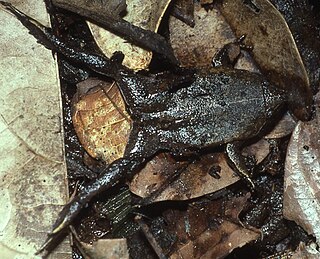
Ctenophryne geayi is a species of frog in the family Microhylidae. It is widely distributed in the northern parts of South America, in the Guianas and in the Amazon Basin in Venezuela, Colombia, Ecuador, Peru, Bolivia, and Brazil. It might actually represent two species.
Boana curupi, the yellow-spotted tree frog, fasciated frog or spotted tree frog, is a frog endemic to Paraguay, Brazil, and Argentina. Scientists have seen it between 300 and 700 m above sea level.
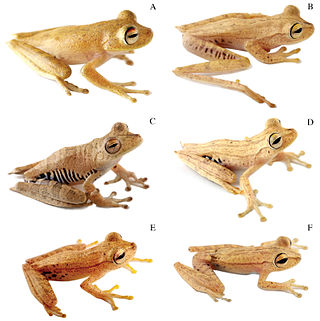
Alfaro's tree frog is a frog in the family Hylidae. It is endemic to Brazil, Ecuador, and Colombia. Scientists think it may also live in Peru. Scientists have seen it between 176 and 350 meters above sea level.
The Canelos tree frog is a frog in the family Hylidae. It is endemic to Brazil, Ecuador, and Colombia. Scientists have seen it between 14 and 1050 meters above sea level.
Boana nigra, the black-flanked tree frog, is a frog in the family Hylidae. It is endemic to Ecuador. Scientists have seen it between 910 and 1847 meters above sea level.
Boana cambui is a frog in the family Hylidae. It is endemic to Brazil. Scientists have seen it 905 meters above sea level.
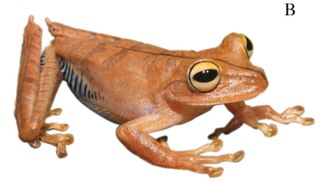
Boana almendarizae, or Almendariz's tree frog, is a frog in the family Hylidae endemic to Ecuador. Scientists have seen it between 500 and 1950 meters above sea level in the Andes Mountains.
Boana ventrimaculata, The Yasuní tree frog, is a frog in the family Hylidae, endemic to Ecuador and Brazil. Scientists have seen it between 64 and 1035 meters above sea level.
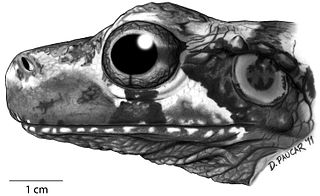
Osteocephalus cannatellai is a frog in the family Hylidae endemic to Ecuador and Colombia. Scientists have seen it between 200 and 1290 meters above sea level.
Boana stellae is a frog in the family Hylidae, endemic to Brazil. Scientists know it from the type locality: between 200 and 600 meters above sea level on the Araucaria plateau in Rio Grande do Sul.
Boana bandeirantes is a frog in the family Hylidae, endemic to Brazil. Scientists have seen it only over 400 meters above sea level.
Boana aguilari is a frog in the family Hylidae, endemic to Peru. Scientists have seen it between 1225 and 2080 meters above sea level.
The tepui tree frog is a frog in the family Hylidae, endemic to Brazil and Venezuela. Scientists have seen it between 420 and 1800 meters above sea level.
